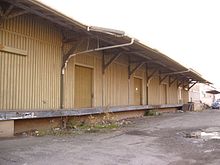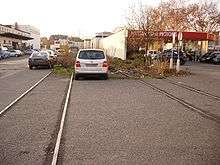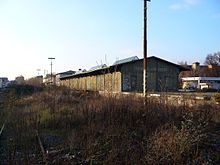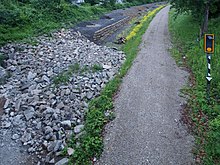Heilbronn Süd train station
| Heilbronn Süd train station | |
|---|---|
 Südbahnhof around 1906
|
|
| Data | |
| Location in the network | Connecting station |
| abbreviation | THS |
| opening | December 1, 1900 |
| Conveyance | August 16, 2000 |
| location | |
| City / municipality | Heilbronn |
| country | Baden-Württemberg |
| Country | Germany |
| Coordinates | 49 ° 7 '53 " N , 9 ° 13' 19" E |
| Railway lines | |
| Railway stations in Baden-Württemberg | |
The Heilbronn South Station was the Heilbronner South City and the railway terminal was opened in 1900, schmalspurigen Bottwartalbahn . The Südbahnhof was connected to the Crailsheim – Heilbronn railway line and thus to Heilbronn Central Station via a connecting line . The station was also used for passenger traffic until 1966, then to a limited extent for handling goods until operations were closed in 1999 due to a lack of traffic. The station building was demolished in 1976 after passenger traffic was shut down in 1966, the remains of the facility in the 2010s.
history
As early as 1891, the Heilbronn municipal council submitted an application for a standard gauge siding for the industrial area in the south of the city to the main station. In 1896 a south station in Heilbronn was planned as the terminus for the narrow-gauge railway Marbach –Heilbronn. This was where the transition between narrow and standard gauge should take place and a standard gauge connection to Heilbronn main station should be established.
Different variants were discussed how to connect the Südbahnhof to the Hauptbahnhof:
- Sontheim –Südbahnhof – Lerchenberg tunnel – confluence with the Crailsheim line
- Sontheim – Südbahnhof – via the later Oststraße – junction with the line from Crailsheim (without tunnel)
- Sontheim – over the Neckar to the Böckinger marshalling yard
The decision was finally made on a standard gauge connection through the Wannental by means of a tunnel through the Lerchenberg, past the Heilbronn main cemetery , over the Jägerhausstraße and finally a connection to the Crailsheim – Heilbronn line.
After long discussions between Heilbronn's municipal council, the then Mayor Hegelmaier and the Royal Württemberg Railway Directorate, it was finally agreed that the necessary land for the track system should be acquired by the city and that it would be transferred to the railroad free of charge and unencumbered. The city also had to make a financial contribution to the railway construction of 115,000 marks . An agreement to this effect was signed on September 23, 1897.
The opening of the station took place on December 1, 1900 together with the opening of the last section of the Bottwartalbahn without any major celebrations.
On April 11, 1901, the connecting line Heilbronn-Süd – Pfühl branch was opened, and the station was able to fully commence operations.
business
At the station, goods were handed over between normal and narrow gauge. Smaller companies loaded their goods directly at the train station, some large companies had a siding.
Investments
In addition to a small locomotive shed and an 8 m turntable, there was also a coaling system with an electrically operated crane for loading locomotives with Hunten . For goods traffic there was a goods shed with a loading ramp between narrow and standard gauge.
Freight transport
For a long time, the Südbahnhof was of relatively great importance as a freight station , as many well-known companies transshipped their goods at the Südbahnhof and it served up to eight company sidings. A large part of the fruit and vegetables required by the Heilbronn residents was transhipped here. Standard-gauge freight trains could be jacked up on roller bolsters and transported on the narrow-gauge without reloading. After the Second World War, there was also a street scooter operation . Occasionally vehicles and tanks of the US Army stationed in Heilbronn's south were also loaded and showman trains dispatched.
The annual sugar beet harvest was a big event , as the Heilbronn sugar factory was supplied with beets via the Bottwartalbahn and the Südbahnhof. After the commissioning of the new Offenau sugar factory, a significant part of the goods volume collapsed after 1970. Seifenwerke Flammer also ceased operations at the end of the year.
Goods volume 1965:
- Wagonload traffic : Arrival of 12,340 freight wagons (including 5,000 wagons with 100,000 t of beet) and departure of 3,450 wagons
- General cargo traffic: 12,000 consignments of 1,770 t received and 23,400 consignments of 2,774 t sent
- Through traffic: 826 t general cargo reloaded
passenger traffic
The Südbahnhof was the terminus of the Marbach – Heilbronn railway line. In the planning phase of the station and the railway line, it was also planned to run a passenger service from Heilbronn main station via the connecting line to Sontheim, but this was not implemented. After the Second World War, workers' trains ran from Eppingen to Sontheim via the Südbahnhof. Incoming travelers who wanted to travel on via the main train station had to use the Heilbronn tram , which connected the two stations. This in turn was replaced in 1951 by the Heilbronn trolleybus, which ran until 1960 .
Decline
With the decline of the Bottwartalbahn, operations at the Südbahnhof were also thinned out more and more. According to the Federal Railway , the tracks to Sontheim were retained in 1968 because of well-known companies. In October 1967, the Südbahnhof freight handling point was assigned to Heilbronn Hauptbahnhof. However, the Bundesbahn emphasized that the Südbahnhof would not be available even after the Bottwartalbahn was shut down. On April 1, 1975, the clearance rights for general cargo and express cargo were transferred to the main station as part of a new concept by Deutsche Bahn.
The Knorr company , now Unilever Bestfoods , was the last company to handle goods through the station. DB Cargo presented September 30, 1999, a transport operation because of lack of traffic on the track, which Unilever Bestfoods its transport trucks had to handle. This meant that the train station and the Pfühl-Südbahnhof branch line were without traffic.
The tracks and buildings of the narrow-gauge railway were dismantled shortly after the same was closed. The old, dilapidated station building was no longer needed and was also demolished. On May 2, 1970, a 10 m high brick building and a crane foundation were blown up.
Passenger traffic ceased on September 26, 1966. The closure of the narrow-gauge railway on December 31, 1968 was followed by the standard-gauge section Talheim – Sontheim on May 28, 1976 and the connecting line to the main train station on August 15, 2000, and thus the final end of the history of the station in the south of Heilbronn.
In its heyday, the Federal Railroad employed up to 30 civil servants and workers at the station.
Conversion
A new residential area on the area around the train station has been discussed since the 1990s. In 2009, the former railway subsidiary Aurelis took over the 5.6 hectare site and began demolishing buildings that were no longer in use.
After the development plan procedure was running in 2012, the new development plan for the area of the former south station was adopted in mid-2013. This provides for living space to be created on the site in the form of a new urban quarter with around 380 apartments and around 800 residents. Individual commercial and office buildings are to be added. The start of construction work was scheduled for the end of 2013, the completion of the first apartments for the end of 2014, and the completion of the project in 2019.
In 2017, the Local Agenda 21 advocates the “continuation of the southern axis into the Zabergäu and Bottwartal”. A reactivation of the Südbahnhof and the Lerchenberg tunnel is imperative for this.
literature
- Roland Rösch: The railway in the south of Heilbronn . In: Christhard Schrenk (Ed.): Heilbronnica 2 - Contributions to the city's history . City of Heilbronn, Heilbronn 2003, ISBN 3-928990-85-3 ( PDF, 1.1 MB ).
Individual evidence
- ↑ List of lines closed since the rail reform ( page no longer available , search in web archives ) Info: The link was automatically marked as defective. Please check the link according to the instructions and then remove this notice. on the website of the Federal Railway Authority
- ↑ Hans-Joachim Knupfer / Josef Högemann, Bottwar- and Zabergäu Railway, publishing Kenning, north horn 1992 ISBN 3-927587-07-9
- ↑ Heilbronn Voice of March 2, 1966 No. 50. p. 9.
- ↑ Heilbronn Voice of April 7, 2001, p. 23.
- ↑ Everyday communal life of June 30, 2000 No. 6/2000.
- ↑ Heilbronn voice of April 30, 1970 No. 90, p. 15.
- ^ Südbahnhof: New living instead of tracks In: Immobilien Zeitung April 8, 2010. Accessed on September 29, 2015.
- ↑ jof: South Station key projects of urban development . In: Heilbronn voice . February 7, 2012 ( from Stimme.de [accessed on September 14, 2012]).
- ↑ Signals to green for Südbahnhof - Heilbronn voice . Retrieved August 12, 2013.
- ↑ Development opportunity at the Südbahnhof In: Immobilien Zeitung November 29, 2012. Accessed September 29, 2015.
- ↑ Kilian Krauth: The citizens' movement Local Agenda 21 invites all interested parties to five dates this spring to collect ideas for a sustainable public transport concept in the city of Heilbronn. In: Heilbronn voice . February 12, 2017 ( from Stimme.de [accessed on February 12, 2017]). : "With the Stadtbahn, the continuation of the southern axis into the Zabergäu and the Bottwartal should not be forgotten."






